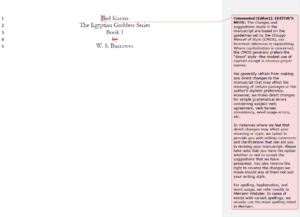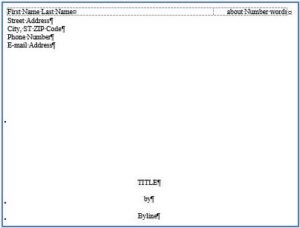Post: Creating Your Manuscript

Creating Your Manuscript
Introduction
So, you’ve written a book, or you are currently writing a book. You want to get your book published, and you’re wondering how to go about doing that. This is where you create your calling card, the manuscript.
Presentation is everything.
The Manuscript
The manuscript is the first 50 pages of your book. This is the introduction to agents and publishers that will be reviewing your book and deciding if they want to represent or publish you. Presentation is indeed everything when exhibiting your work. There are industry standards that you should adhere to if you want these people to look at your work. It would be a shame to have this great piece of art to bestow unto the world, and it gets ignored because it was not presented properly to the powers that be.
Fig. 1
Most text editors will have a word count feature. If yours does not, I highly recommend Microsoft Word 365 not only for that feature, but the Reference feature, especially the Citations & Bibliography Style, which ranges from APA, Chicago all the way up to Turabian. My publisher uses the Chicago citation style. (See Fig. 2).
My publisher uses the Chicago citation style.

Fig. 2
As a seasoned writer, I prefer to use Microsoft Word as my word editor. One of the awesome things about Microsoft Word is there is a built-in template for manuscripts. Just type manuscript in the search box under File, New. (see Fig. 3).

Fig. 3
If you have a student or work account, you can access Microsoft 365 for free. If a Microsoft subscription is not in your budget, you can always use any free word editor. Google Docs is a free, popular word editor that has similar features, like the Citation feature. You can find it on the menu bar under Tools, Citations. (see Fig. 4).

Fig. 4
What’s the Format?
The line spacing should be double-spaced. The really great thing about this is, you are still only submitting 50 pages. So, if you’ve written in single space, you are actually only submitting the first 25 pages. People always assume they must have a finished work, but that is simply not the case. When I got my book deal, I was only half-way through my book. I will talk about how my book deal came into play in another article, but suffice it to say, you do not have to be finished with your project to get a book deal.
you do not have to be finished with your project to get a book deal
Your paragraphs should have a 0.5” left indent which amounts to five spaces or half inch and be left justified. Your margins should be one inch all around. Chapters start on a new page, that’s just a given. Now let’s talk about spacing – two spaces or one after a period, that is the debate. In earlier times, traditionally publishers and printers used extra space between sentences mainly because they were using monospace presses which means that every letter took up the same amount of space.
the standard for today’s type is one space after a period
After the 1950s, magazines and publications started using the single space after the period primarily because typesetting became proportional which means the space of a letter was proportionate to the size of the font. According to The Complete Manual on Typography: A Guide to Setting Perfect Type (Felici 2011), the standard for today’s type is one space after a period, question mark, exclamation point, or colon.
The Summary
After the cover page, you are going to write a summary. The summary is a brief synopsis of your book. This is like the appetizer that most of us read on the back of the book, except this is a more factual version of that. It should be no longer than one page. Below is an example of a summary for my book, Bad Karma:
Summary
A prophesy that twin sisters will destroy Seth and take back the Earth to usher in a golden era, spurs Seth to kidnap Karma, the eldest of twins born to Ra and Hathor. Karma believes Seth is her father, and has no idea of the evil plan to use her against her real father Ra. She has been taught that Ra is the enemy bent on destroying her world, and her powers have been muted by Seth until the appointed time to unleash them. On the day of her betrothal to Khonsu, the moon god, she is again kidnapped by a rival who intends to use her powers for his own agenda. Will Khonsu be able to find Karma in time to reunite her with her father and save the planet, or will she be instrumental in its demise?
The summary is like the appetizer that most of us read on the back of a book.
Biography
The third page of your manuscript is the Biography. Your biography is a great marketing tool for introducing yourself to your audience. This page describes you, the author. You can describe your literary accomplishments if you have any. You want your audience to know a little about you, like where you’re from, what makes you an authority on the book you’re writing, mention your blog or any previous books that you’ve written, drop names if it is relevant without going overboard. Keep it interesting. Remember, you are selling yourself, so highlight your attributes in the most positive light. Most people will read the About the Autho
Aenean nec porttitor augue. Ut ultricies commodo magna nec accumsan. Sed varius neque vel erat finibus, ut mollis lacus vestibulum. In feugiat nisl maximus finibus vehicula. Maecenas finibus dui ac urna tincidunt volutpat. Morbi commodo laoreet nunc. Curabitur orci quam, mattis non ornare eu, ullamcorper at nulla. Cras id elit posuere, porta ligula et, placerat augue. Curabitur ac malesuada massa. Praesent consequat quam eu tincidunt aliquam. In facilisis dui quis massa sagittis, eget sagittis turpis tempus. Phasellus eget nisl sed purus pharetra molestie.
Proin ut elit et nulla iaculis tempor. Cras eget euismod urna. Donec vitae augue id est ultrices malesuada in et neque. Maecenas ut lacus nec neque pulvinar fringilla. Nullam et nunc interdum orci luctus aliquam vel vitae metus. Morbi tempor metus erat, ut elementum diam varius ac. Ut lorem mauris, sagittis eu aliquam eu, imperdiet ut erat. Nullam non interdum nisi, sit amet cursus neque.
Sed id elit faucibus mi dapibus cursus. In magna justo, porta vestibulum varius nec, laoreet non odio. Donec molestie nibh at ex convallis vestibulum. Orci varius natoque penatibus et magnis dis parturient montes, nascetur ridiculus mus. Integer congue in justo eget suscipit. Proin non metus ultrices sem tincidunt ultrices a eu justo. Integer nec lorem a ante laoreet eleifend ac non nibh.
Aenean molestie pharetra enim eget sagittis. Proin ac diam quis felis ornare consectetur. Fusce eget enim nisi. Aliquam vitae nunc vel nisi imperdiet egestas sed in est. In aliquet dignissim ullamcorper. Morbi hendrerit dolor sed orci fermentum dictum eu feugiat ipsum. Nulla placerat tincidunt ante tempor lobortis. Curabitur non tempor elit. Nulla laoreet nec felis et malesuada. In auctor, erat ut placerat euismod, quam dolor scelerisque velit, sed blandit sem libero nec justo. Morbi maximus nibh sed lacus convallis fringilla. Class aptent taciti sociosqu ad litora torquent per conubia nostra, per inceptos himenaeos. Phasellus orci diam, cursus nec nisi vitae, placerat fermentum nulla. Donec volutpat erat nec eros vehicula varius.
